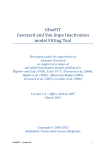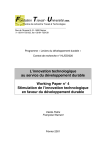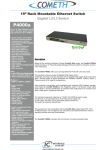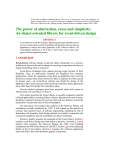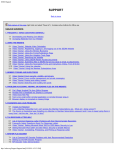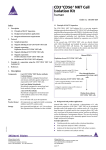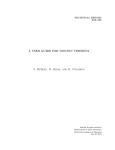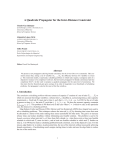Download Manual for GInaFit_V1_3_2
Transcript
GInaFiT Geeraerd and Van Impe Inactivation model Fitting Tool Developed by Dr. Annemie Geeraerd as support of a range of microbial inactivation models published in Bigelow and Esty (1920), Cerf (1977), Geeraerd et al. (2000), Mafart et al. (2002) and Albert and Mafart (2003) Version 1.3 July, 2004 Copyright © 2003-2004 Katholieke Universiteit Leuven (Belgium) GinaFit – Version 1.3.2 1 Disclaimer and Support Disclaimer GInaFiT and this manual come without ANY WARRANTY and are provided “AS-IS”. The software GInaFiT is copyrighted by the Katholieke Universiteit Leuven (KULeuven, Belgium). It is not permitted to include GInaFit in any other application. The program is for research purposes only and should not be solely relied upon for any reason. Acknowledgements If you would like to report results obtained with GInaFiT, may we ask to acknowledge Annemie Geeraerd (Katholieke Universiteit Leuven, Belgium) and the original research publications for the model(s) you selected for your case-study (as provided in the Excel result-sheet(s) and the user manual). Feedback If you would have comments or suggestions regarding the installation, use or content of GInaFiT, please send these comments and suggestions to [email protected] or [email protected]. Updates Possible future updates will be published on the KULeuven/BioTeC homepage, which can be found at http://www.kuleuven.ac.be/cit/biotec Requirements of GInaFit • • MS-Excel 97 or higher The MS-Excel Add-In “Solver” is installed (if not, the Solver can be retrieved on your Office installation CD-ROM). When installed the solver can be retrieved via the menu-item Tools – Solver The solver.xla file is expected to be installed in its standard location, which is, respectively, ü C:\Program Files\Microsoft Office\ Office\ Library\solver for Office 97 or 2000 ü C:\Program Files\Microsoft Office\ Office10\ Library\solver for Office XP ü C:\Program Files\Microsoft Office\ Office\ macrolib\solveur for Office 97 or 2000 – French version If this is not the case GInaFiT will give a compilation error upon installation. If the item “Solver” is not present in the menu-item Tools but the solver.xla file is present on the computer, the solver has to be added to MS-Excel in the same way as described below for GInaFiT. GinaFit – Version 1.3.2 2 Installation of GInaFiT 1. 2. 3. It is suggested to place the file GInaFiT_v132.xla in the directory ü C:\Program Files\Microsoft Office\ Office\Addins for Office 97 or 2000 ü C:\Program Files\Microsoft Office\ Office10\Addins for Office XP Nevertheless, placing at any other location like, for example, C:\temp, is always possible. Start MS-Excel with a blank work sheet. Select Tools -Add-Ins. 4. In the Add-In screen tick the Add-In GInaFiT_v132 when present in the list or select the GInaFiT_v132.xla file by browsing to the directory selected under item number 1. 5. 6. Push OK. When selecting “I agree” after reading some messages (repeated on page 2 of this manual), the menu item GInaFiT will be present in the Worksheet Menu Bar, next to the Help Menu. 7. To remove GInaFit, un-tick the item GInaFiT in the list of Add-Ins and delete the GInaFiT_v132.xla file from the directory chosen under item number 1. GinaFit – Version 1.3.2 3 How to use GInaFiT 1. Select the data to be modelled in the excel sheet. The first column should be time, the second column should be Log10(N). Figure 1: Selection of the data to be modelled 2. Select the model to be applied out of the eight different model structures available as can be seen in the figure below. 3. A new sheet is inserted with the same name as the name of the original sheet followed by the name of the model selected, e.g., Sheet1 would result in Sheet1_Geeraerd_Shoulder_Tail. The result is demonstrated in Figure 2. GinaFit – Version 1.3.2 4 Figure 2: Result when modelling the data represented in Figure 1 using the full model as described in Geeraerd et al. (2000). The tool can be used in two ways. On one hand, for end-users having already a qualitative idea of the general shape of their survival curves, the choice for one of the model types may be obvious. On the other hand, if the end-user does not have a clear idea yet, the different types can be tested and compared based on some reported statistical measures. Additionally, the tool has some built-in features testing for mis -use, for example, when trying to identify a model with tailing on data not having a tail. References Albert I. and P. Mafart 2003. “A modified Weibull model for bacterial inactivation.” In: J.F.M. Van Impe, A.H. Geeraerd, I. Leguérinel and P. Mafart (Eds.), Predictive Modelling in Foods - Conference Proceedings, Katholieke Universiteit Leuven/BioTeC, Belgium, pp. 143-145 (ISBN 90-5682-400-7) (Selected for the Special Issue of International Journal of Food Microbiology following the Fourth International Conference on Predictive Modelling in Foods, June 15-19, 2003, Quimper, France) Bigelow W.D. and J.R. Esty 1920. “The thermal death point in relation to typical thermophylic organisms”, Journal of Infectious Diseases, 27, 602-617. Cerf O. 1977. “A review. Tailing of survival curves of bacterial spores.” Journal of Applied Microbiology, 42, 119. Geeraerd A.H., C.H. Herremans and J.F. Van Impe 2000. “Structural model requirements to describe microbial inactivation during a mild heat treatment.” International Journal of Food Microbiology, 59, 185-209. Mafart P., O. Couvert, S. Gaillard and I. Leguerinel 2002. “On calculating sterility in thermal preservation methods: application of the Weibull frequency distribution model.” International Journal of Food Microbiology, 72, 107-113. GinaFit – Version 1.3.2 5 Acknowledgements Annemie Geeraerd is a Postdoctoral Fellow of the Fund for Scientific Research - Flanders (Belgium) (F.W.O.Vlaanderen) working at BioTeC – Bioprocess Technology and Control Research Group of KULeuven. Mieke Janssen, Arnout Standaert, Vasilis Valdramidis and Karen Vereecken (KULeuven/BioTeC) are gratefully acknowledged for their help in testing earlier versions of this tool, as well as Marie Cornu (AFSSA, France) for her help to establish the French version. Current research at BioTeC in predictive modelling in foods is supported by the Research Council of the Katholieke Universiteit Leuven as part of projects OT/99/24, the Institute for the Promotion of Innovation by Science and Technology in Flanders as part of project STWW 980366, the Fund for Scientific Research Flanders (FWO-Vlaanderen) as part of project G.0213.02, the Belgian Program on Interuniversity Poles of Attraction and the Second Multi annual Scientific Support Plan for a Sustainable Development Policy, initiated by the Belgian Federal Science Policy Office, and the European Commission as part of project QLK1-CT-200101415. GinaFit – Version 1.3.2 6












